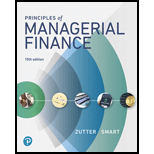
a)
To discuss:
Risk preferences.
Introduction:
Risk: The risk can be defined as the uncertainty attached to an event such as investment where there is some amount of risk associated to it as there can be either gain or loss.
Return: In financial context, return is seen as percentage that represents the profit in an investment.
The standard deviation measures the volatility of the stock. It measures in absolute terms the dispersion of asset risk around its mean.
b)
To discuss:
Risk preferences.
Introduction:
Risk: The risk can be defined as the uncertainty attached to an event such as investment where there is some amount of risk associated to it as there can be either gain or loss.
Return: In financial context, return is seen as percentage that represents the profit in an investment.
The standard deviation measures the volatility of the stock. It measures in absolute terms the dispersion of asset risk around its mean.
c)
To discuss:
Risk preferences.
Introduction:
Risk: The risk can be defined as the uncertainty attached to an event such as investment where there is some amount of risk associated to it as there can be either gain or loss.
Return: In financial context, return is seen as percentage that represents the profit in an investment.
The standard deviation measures the volatility of the stock. It measures in absolute terms the dispersion of asset risk around its mean.
d)
To discuss:
Risk preferences.
Introduction:
Risk: The risk can be defined as the uncertainty attached to an event such as investment where there is some amount of risk associated to it as there can be either gain or loss.
Return: In financial context, return is seen as percentage that represents the profit in an investment.
The standard deviation measures the volatility of the stock. It measures in absolute terms the dispersion of asset risk around its mean.
Want to see the full answer?
Check out a sample textbook solution
Chapter 8 Solutions
Gitman: Principl Manageri Finance_15 (15th Edition) (What's New in Finance)

